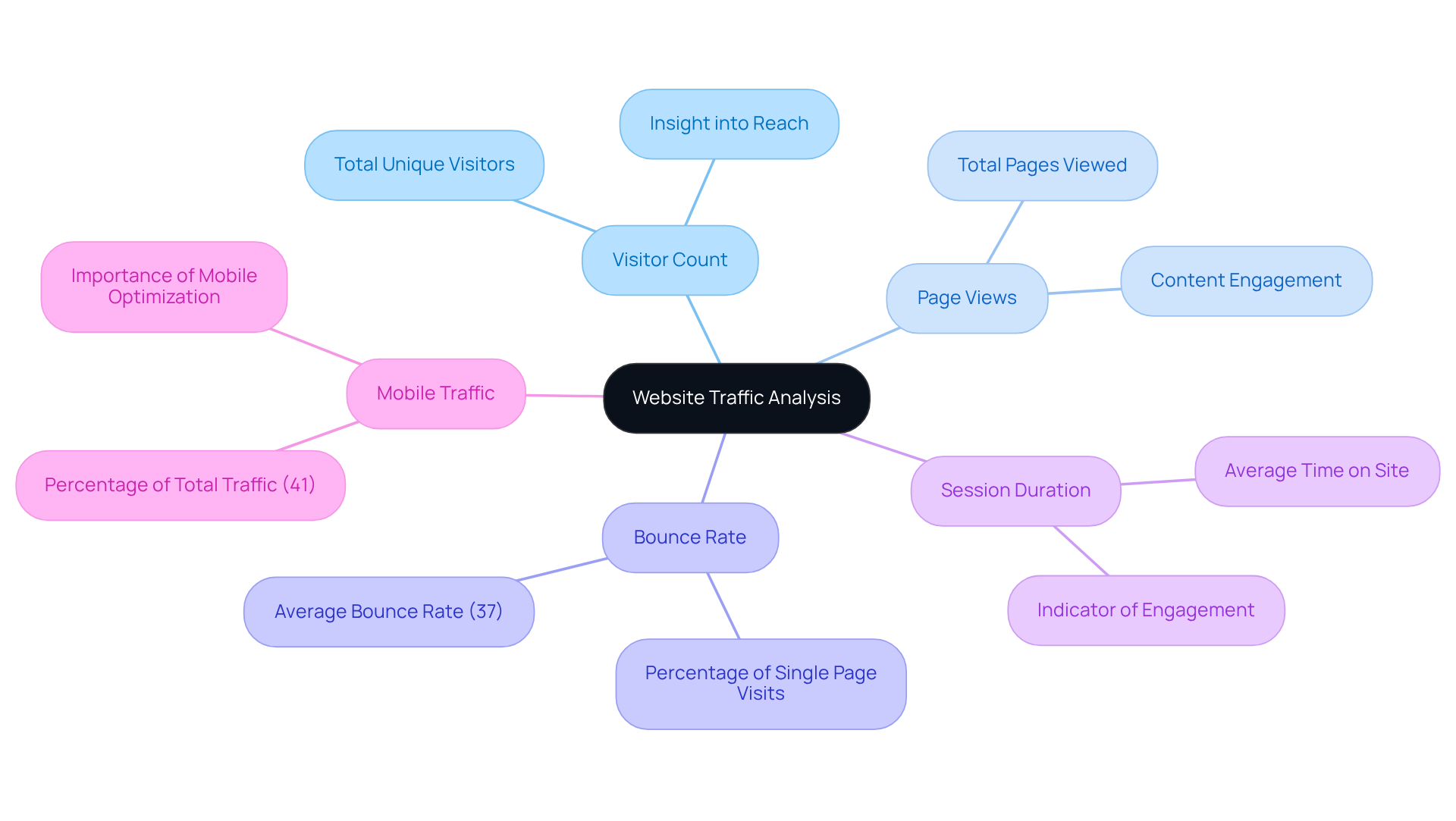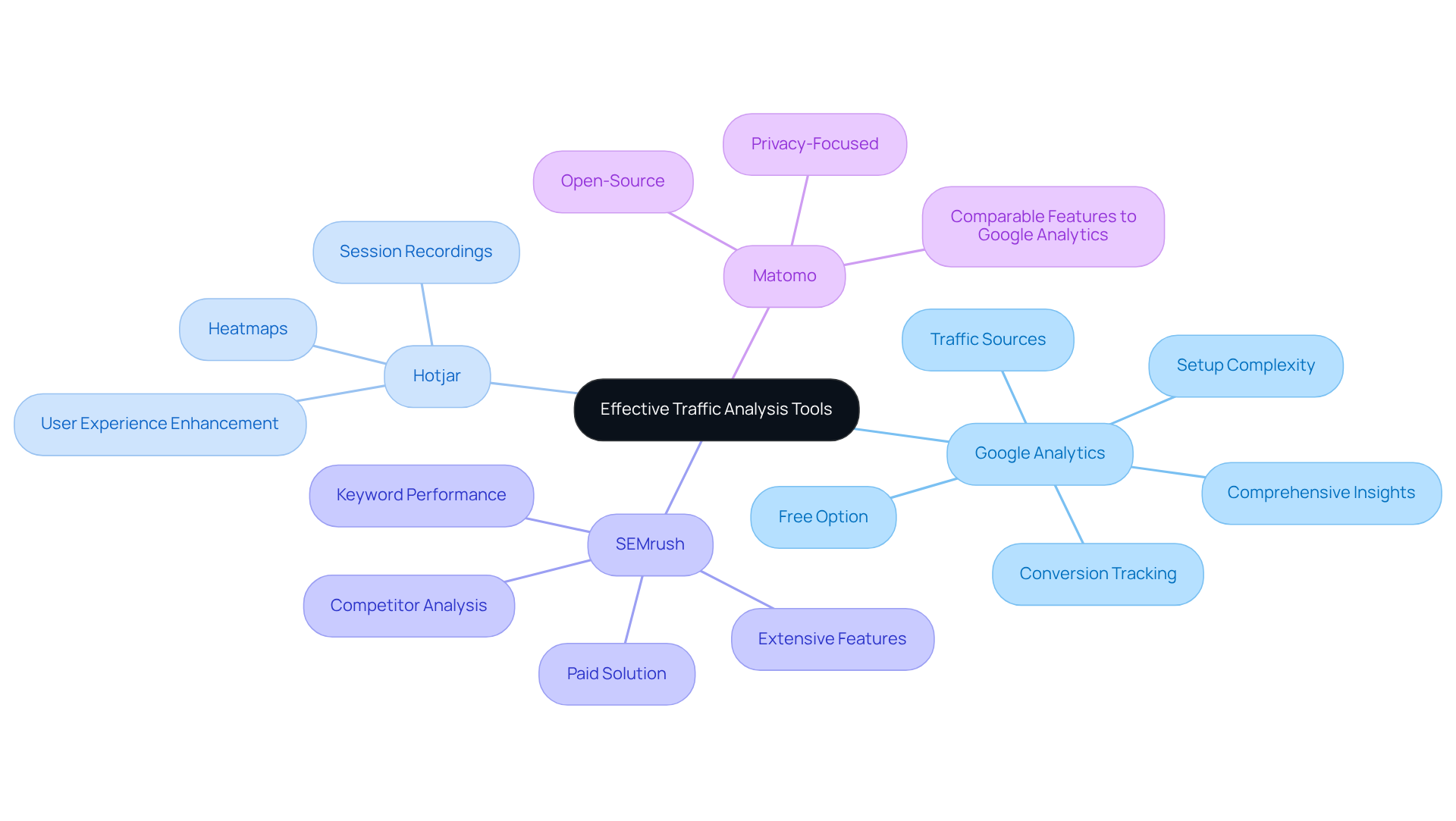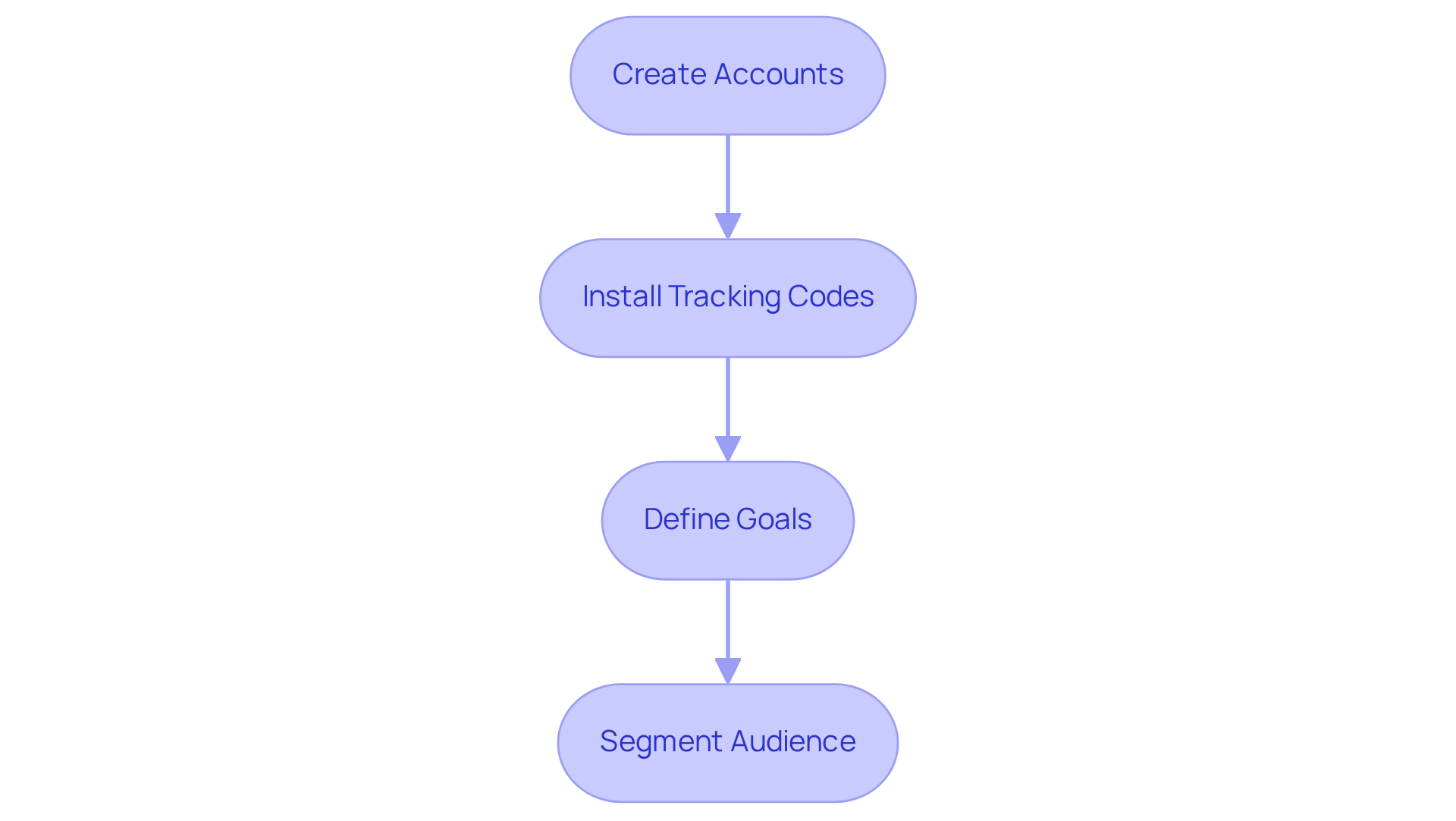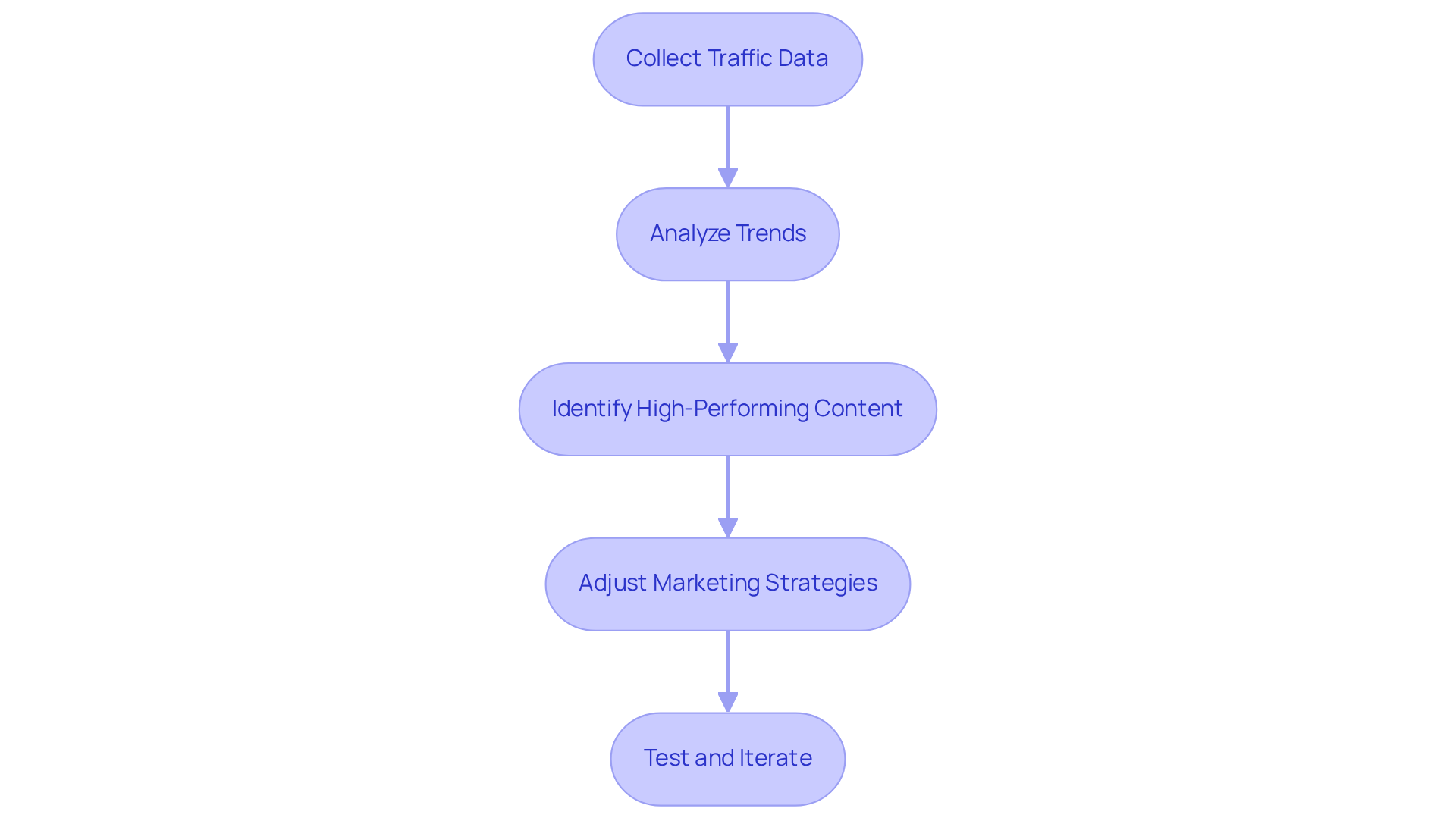Overview
In today’s fast-paced digital landscape, tech startups often find themselves grappling with the challenge of effectively analyzing website traffic. This struggle can lead to feelings of frustration and uncertainty, as understanding visitor behavior is crucial for success. Metrics like visitor count, bounce rate, and session duration are not just numbers; they represent the heartbeat of your online presence. Without a clear grasp of these insights, startups may miss opportunities to connect with their audience and drive growth.
But there’s hope. By implementing a structured framework for data collection and interpretation, you can transform this daunting task into a powerful tool for your marketing strategy. Imagine having the clarity to optimize user engagement and make informed decisions that propel your startup forward. This four-step process is designed to guide you through understanding your visitors, nurturing their experience, and ultimately fostering a thriving community around your brand.
We invite you to embrace this journey with us, as we provide the support and expertise you need to navigate these waters. Together, we can turn the complexities of website traffic analysis into a pathway for growth and success, ensuring that your startup not only survives but flourishes in the digital age.
Introduction
For tech startups, analyzing website traffic is not just a task; it's a vital journey toward understanding their audience and enhancing their online presence. Many founders find themselves overwhelmed when trying to decipher visitor behavior and key metrics, often feeling lost in a sea of data. This struggle can lead to missed opportunities for growth and engagement, leaving them wondering how to make informed decisions in such a complex landscape.
But you are not alone in this. This guide offers a structured approach to traffic analysis, designed to empower you to harness data effectively. Together, we can navigate this intricate world, turning insights into strategic advantages that foster sustainable success. By sharing these experiences and insights, we aim to create a supportive community where your challenges are understood and addressed.
Understand Website Traffic Analysis
For technology companies, it is vital to [analyze website traffic](https://blog.hubspot.com/website/web-traffic-analytics-report) as it involves examining visitor behavior and interactions with your content. Many founders find themselves grappling with understanding how their audience engages with their site. This can feel overwhelming, but recognizing key metrics can illuminate the path forward.
- Visitor Count: This metric reflects the total number of unique visitors to your site over a specific timeframe, offering insight into your reach and audience engagement.
- Page Views: The total count of pages viewed demonstrates how captivating and pertinent your content is to visitors, helping you gauge their interest and connection to your offerings.
- Bounce Rate: This percentage represents visitors who leave after viewing only one page. A significant bounce rate, averaging approximately 37% for tech startup sites in 2025, may indicate challenges with content relevance or overall experience, prompting a deeper examination. Interestingly, the average website also has a bounce rate of 37%, providing a useful benchmark for comparison.
- Session Duration: The average time visitors spend on your site is a key indicator of engagement levels. Extended session lengths usually suggest that individuals find your content valuable and are more inclined to convert.
- Mobile Traffic: With mobile devices accounting for 41% of website traffic, optimizing your site for mobile visitors is crucial for enhancing engagement and experience.
Understanding these metrics is essential to , assess the effectiveness of your marketing strategies, and make informed decisions to enhance user experience and drive conversions. For instance, eCommerce platforms that analyze website visitor behavior have successfully optimized their sites, leading to increased engagement and sales. Digital marketing specialists emphasize the importance of these metrics, noting that to analyze the website comprehensively can significantly influence a new business's growth trajectory. As the landscape evolves, staying informed about current website visitor data and trends becomes crucial for technology companies aiming to innovate and thrive. Furthermore, with Google serving as the largest source of referrals, representing 63.41% of them, focusing on SEO strategies is essential for boosting visitor numbers.
By embracing these insights, you can foster a deeper connection with your audience, ultimately paving the way for growth and success.

Select Effective Traffic Analysis Tools
Tech startups often face the challenge of effectively [analyzing website visitor patterns](https://kinsta.com/blog/website-traffic-analysis), which can feel overwhelming when trying to analyze website traffic. Understanding visitor behavior is crucial, yet the plethora of tools available to analyze website data can add to the confusion. Many founders find themselves struggling to navigate complex analytics platforms, which can lead to frustration and missed opportunities for growth.
Fortunately, there are several powerful tools tailored to meet the unique needs of startups.
- Google Analytics stands out as a free option that provides comprehensive insights into visitor behavior, traffic sources, and conversion tracking. While it’s essential for , its setup can be daunting for beginners, making it important to approach it with patience.
- Another great option is Hotjar, which is well-known for its heatmaps and session recordings. It visualizes interactions on your site, helping you pinpoint areas for improvement and enhance the user experience. This can be particularly valuable for startups aiming to create a welcoming environment for their visitors.
- For those looking for a more in-depth analysis, SEMrush offers a robust paid solution. It provides insights into source origins, competitor analysis, and keyword performance, equipping new businesses with the knowledge needed to refine their strategies. However, its extensive features may feel overwhelming at first, so taking the time to explore them gradually can be beneficial.
- Lastly, Matomo serves as an open-source alternative to Google Analytics, prioritizing privacy. This makes it an appealing choice for startups concerned about data protection while still offering comparable features.
When selecting the right tool, it’s essential to consider factors such as ease of use, integration capabilities, and how well it aligns with your specific analytical needs. Remember, swiftly analyzing website user engagement and behavior data is crucial for crafting an effective action plan. Focus on key performance indicators (KPIs) like visitor volume, sources of visitors, and conversion rates. By taking this thoughtful approach, you can ensure that your chosen tool will effectively support your analysis efforts and ultimately lead to greater success.

Set Up Your Traffic Analysis Framework
Establishing an effective traffic analysis framework for your tech startup can feel overwhelming, but you’re not alone in this journey. Many founders struggle with understanding how to harness data effectively, which can lead to frustration and missed opportunities. But don’t worry; by following these essential steps, you can create a structured approach that supports your growth.
- Create accounts with key analytics tools like Google Analytics and Hotjar. Take your time with their setup instructions to ensure everything integrates smoothly. This initial step lays the groundwork for understanding your visitors' behaviors.
- Install the tracking codes. For Google Analytics, embedding the tracking code in your website’s header is crucial. This code gathers important information on visitor interactions, helping you analyze website user engagement.
- Define your goals. Clearly outline specific objectives within your analytics tool, such as monitoring newsletter sign-ups or product purchases. This step is vital for assessing the effectiveness of your marketing strategies and ensuring they align with your business objectives.
- Don’t forget to segment your audience. Utilize the analytics tools to based on demographics, user behavior, or traffic sources. This segmentation allows for targeted analysis, enabling us to analyze website interactions and provide deeper insights into how different groups engage with your site.
By applying this structured framework, you can ensure that your information collection is organized, relevant, and aligned with your startup's growth objectives. As Tim O'Reilly wisely noted, 'We’re entering a new world in which information may be more important than software.' In today’s digital environment, where we generate information comparable to the Library of Congress daily, establishing a robust analytics framework is more crucial than ever.
Furthermore, be mindful that Google Analytics alerts users when their traffic volume surpasses 10 million hits each month. This is an important factor to consider as your startup grows. Remember, every step you take in understanding your data brings you closer to your goals, and you have the support you need to navigate this journey.

Interpret and Utilize Traffic Data
Once you have collected data, it’s time to interpret and utilize it. Many tech startup founders face the challenge of making sense of their traffic data, which can feel overwhelming. Yet, understanding this information is crucial for growth and success.
- Analyze Trends: Take a moment to examine your traffic data for patterns over time. You might notice specific days or times when congestion surges occur. Recognizing these trends can guide your content publishing schedule. For instance, did you know that 68% of online experiences begin with ? This insight suggests that optimizing your content for peak usage times can significantly enhance your visibility. Moreover, with organic search expected to represent 53% of all website visits by 2025, focusing on SEO strategies is essential for your startup's future.
- Identify High-Performing Content: It’s important to pinpoint which pages yield the highest engagement and conversion rates. This insight allows you to replicate successful content types. In fact, content marketing leaders experience conversion rates six times higher than those who do not prioritize it. As one specialist wisely noted, "Even if search engines no longer prioritize your site, enhancing conversion rates maintains your business's strength during unforeseen declines in visitor numbers."
- Adjust Marketing Strategies: If you find that certain sources of visitors, like social media or organic search, are underperforming, consider reallocating your resources or modifying . With 54.67% of website visitors arriving from mobile devices, ensuring your strategies are mobile-friendly can truly enhance performance.
- Test and Iterate: Implementing A/B testing can be a game changer. By examining different content formats, headlines, or calls to action based on your visitor insights, you can discover what resonates best with your audience. Ongoing improvement is essential; for example, 43% of web analysts indicated a rise in year-over-year web visits for their main website, emphasizing the success of iterative testing. Additionally, consider exploring case studies, such as RNO1's partnerships with prominent brands, to understand how evaluating visitor patterns can lead to successful outcomes.
By effectively interpreting and utilizing your traffic data, you can analyze your website to make informed decisions that enhance its performance and drive growth for your tech startup. Remember, you’re not alone in this journey—support is available to help you succeed.

Conclusion
Understanding website traffic analysis can feel overwhelming for tech startups striving to succeed in a competitive landscape. The challenge lies in deciphering visitor behavior and engagement metrics, which are crucial for making informed decisions that enhance user experience and drive conversions. This article presents a compassionate approach to analyzing website traffic, emphasizing the importance of:
- Selecting the right tools
- Establishing a structured framework
- Interpreting data effectively
Key insights reveal the significance of metrics such as:
- Visitor count
- Bounce rate
- Session duration
These elements collectively paint a clearer picture of audience engagement, but they can also be sources of frustration if not understood properly. Choosing appropriate analytics tools like Google Analytics and Hotjar can simplify the data collection process, alleviating some of that stress. By setting up a traffic analysis framework and interpreting trends, startups can not only refine their marketing strategies but also optimize their content for maximum impact.
Ultimately, the ability to analyze and utilize website traffic data transcends mere technical necessity; it becomes a strategic imperative for growth. Embracing these practices allows tech startups to foster deeper connections with their audience, adapt to changing dynamics, and position themselves for long-term success. The journey of understanding website traffic is ongoing, and with the right tools and insights, every startup can unlock its potential in the digital realm. Remember, you are not alone in this journey; together, we can navigate the complexities of website traffic and turn challenges into opportunities for growth.
Frequently Asked Questions
Why is website traffic analysis important for technology companies?
Website traffic analysis is crucial for technology companies as it helps examine visitor behavior and interactions with content, allowing founders to understand audience engagement and make informed decisions to enhance user experience and drive conversions.
What does the visitor count metric indicate?
Visitor count reflects the total number of unique visitors to a site over a specific timeframe, providing insight into reach and audience engagement.
How do page views help assess content effectiveness?
Page views indicate the total count of pages viewed, demonstrating how captivating and relevant the content is to visitors, which helps gauge their interest and connection to the offerings.
What does a high bounce rate signify?
A high bounce rate, which averages around 37% for tech startup sites, indicates that many visitors leave after viewing only one page, suggesting potential issues with content relevance or overall user experience.
Why is session duration an important metric?
Session duration measures the average time visitors spend on a site, with longer sessions indicating higher engagement levels and suggesting that visitors find the content valuable and are more likely to convert.
What percentage of website traffic comes from mobile devices?
Mobile devices account for 41% of website traffic, highlighting the need for optimizing sites for mobile visitors to enhance engagement and user experience.
How can analyzing website visitor behavior impact eCommerce platforms?
eCommerce platforms that analyze website visitor behavior can optimize their sites, leading to increased engagement and sales.
What role does SEO play in website traffic?
SEO strategies are essential for boosting visitor numbers, especially since Google serves as the largest source of referrals, representing 63.41% of them.
What should technology companies focus on to thrive in a changing landscape?
Technology companies should stay informed about current website visitor data and trends, as this knowledge is crucial for innovation and growth.




